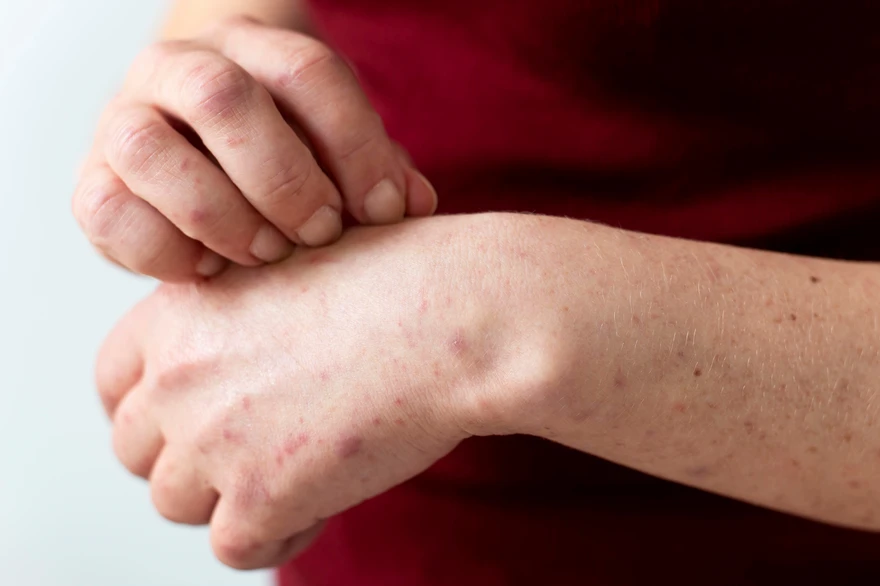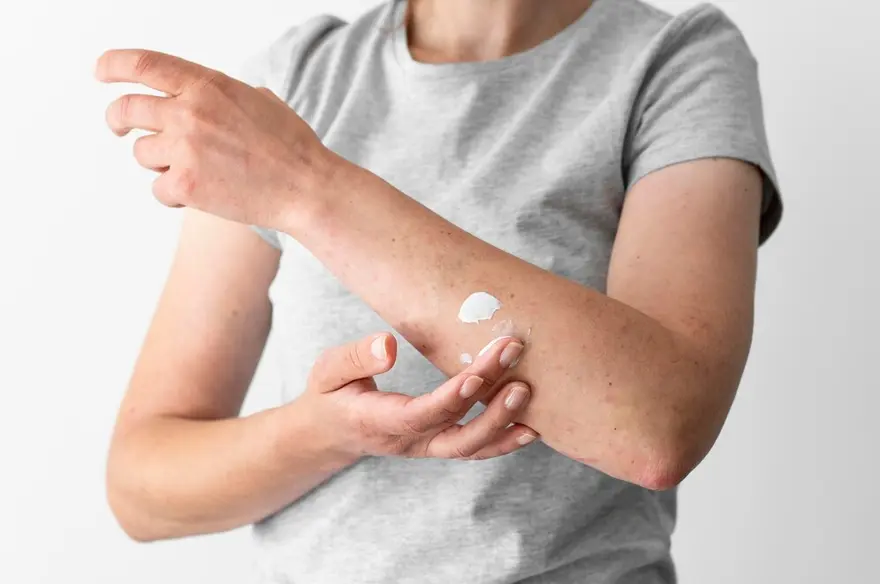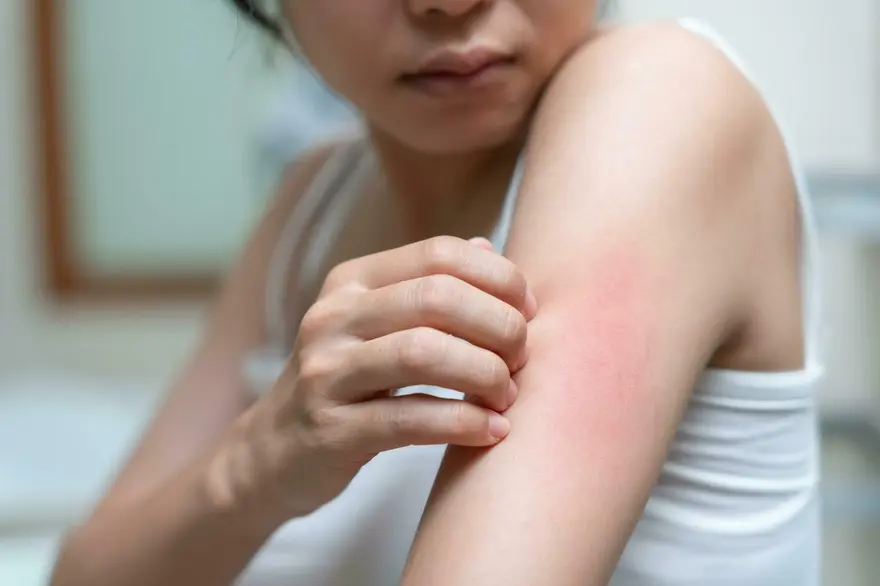Preventive Healthcare
Folliculitis: Symptoms, Causes, and Treatment Approaches
2033 Views
0

What is Folliculitis?
Folliculitis is a bacterial or fungal infections which causes inflammation of hair follicles, This is a common skin condition which manifests symptoms such as small red bumps, pustules, or pimples around hair follicles, which are often accompanied by itching and tenderness. Folliculitis types vary based on the depth and cause of the infection.
Folliculitis treatment depends upon the type and severity of the condition, ranging from topical antibiotics and antifungal medications to more intensive therapies for chronic or severe cases. Proper hygiene, avoiding tight clothing, and using clean shaving equipment can help prevent folliculitis types and manage existing outbreaks.
What are the types of Folliculitis?
Folliculitis is a common skin condition which is characterized by the inflammation of hair follicles, causing red pimple-like bumps or pustules.
Understanding the folliculitis types is essential for proper diagnosis and treatment. Here are the main types:
- Bacterial Folliculitis: This is the most common folliculitis type, usually caused by Staphylococcus aureus bacteria. It appears as red, pus-filled bumps that can form anywhere on the body where hair grows. Proper hygiene and topical antibiotics are usually effective treatments.
- Hot Tub Folliculitis: Caused by Pseudomonas aeruginosa, this folliculitis type is associated with poorly maintained hot tubs and pools. Symptoms include itchy, red bumps that can develop into pustules. It usually resolves on its own but severe cases may require medical treatment.
- Pseudofolliculitis Barbae: Also known as razor bumps, this folliculitis type occurs when hair curls back into the skin after shaving, causing inflammation. It is common in people with curly hair and is usually seen on the face and around the neck. Treatment includes proper shaving techniques and sometimes topical medications.
- Fungal Folliculitis: Caused by fungi such as Candida or Malassezia, this folliculitis type appears as red, itchy bumps. It often occurs in warm, moist areas of the body. Antifungal creams or oral medications are commonly used for treatment.
- Viral Folliculitis: This rare folliculitis type is caused by viruses like herpes simplex or varicella-zoster. It appears as clusters of small, painful blisters. Antiviral drugs are usually prescribed for treatment.
- Eosinophilic Folliculitis: This folliculitis type is more common in people with HIV/AIDS and presents as itchy, red bumps primarily on the face and upper body. The exact cause is unknown, but it is thought to be related to an immune response. Treatment includes topical corticosteroids and antihistamines.
- Gram-Negative Folliculitis: This folliculitis type can develop after prolonged antibiotic treatment for acne, leading to an overgrowth of gram-negative bacteria. It requires specialized antibiotic therapy.
- Pityrosporum Folliculitis: Caused by the family of yeast usually found on the skin (Malassezia), it appears as itchy, acne-like bumps on the back, chest, and shoulders. Antifungal treatments are used to manage this folliculitis condition.
Understanding the types of folliculitis is crucial for effective treatment. Proper folliculitis diagnosis by a healthcare professional can ensure the appropriate management and relief of symptoms, improving overall skin health.
How often does Folliculitis occur?
Folliculitis is relatively a common condition affecting men and women both equally, irrespective of age. However, Certain types of folliculitis are more likely to occur in certain ethnic groups. Certain factors like having a weakened immune system or damaged hair follicles can increase your risk. The frequency of occurrence can vary from person to person depending on these factors.
How common is Folliculitis?
While precise statistics on the prevalence of folliculitis in India are lacking, worldwide studies suggest that it's quite common. As per the American Osteopathic College of Dermatology, nearly every person will experience some form of folliculitis during their lifetime.
What are the symptoms of Folliculitis?
Primary folliculitis symptoms include:
- Clusters of small red or white bumps or pimples that may have a hair at their center
- Blisters filled with pus that break open and crust over
- Itchy, burning and painful skin
- An inflamed, red and swollen bump
The severity of these folliculitis symptoms can vary, with some people experiencing mild discomfort while others might find it extremely bothersome.
What causes Folliculitis?
There are numerous folliculitis causes, but some of the most common is an infection with bacteria, especially Staphylococcus aureus.
Other factors that can cause folliculitis include:
- Fungal infections
- Viral infections
- Inflammation from ingrown hairs
- Blocked hair follicles due to tight clothes or poor hygiene
- Prolonged exposure to harmful substances like coal tar or creosote
How is Folliculitis diagnosed?
In most of the cases, a physical examination of your skin and medical history review is enough for a healthcare provider to diagnose folliculitis. A doctor may take a swab from the infected area to test for bacteria or fungi. In rare cases of folliculitis, a biopsy might be necessary. However, if the condition doesn't improve with treatment, additional tests may be required.
How is Folliculitis treated?
Folliculitis treatment depends on the type and severity of the condition.
- For mild cases, self-care measures such as warm compresses, proper hygiene, and avoiding tight clothing may be sufficient. Topical treatments like antibacterial or antifungal creams are effective for bacterial and fungal folliculitis, respectively.
- In severe or persistent folliculitis cases, oral antibiotics or antifungal medications may also be prescribed. For pseudofolliculitis barbae, adjusting shaving techniques or using electric razors can help prevent recurrence. Avoiding hot tubs or pools with improper sanitation is crucial for preventing hot tub folliculitis.
It's essential to consult a healthcare provider for an accurate folliculitis diagnosis and appropriate folliculitis treatment plan, especially if it is recurring or accompanied by severe symptoms like fever or spreading rash. Proper folliculitis treatment not only relives symptoms but also reduces the risk of complications such as scarring or secondary infections.
Can folliculitis be prevented?
While it's not always possible to prevent folliculitis, you can reduce your risk by practicing a good skin hygiene. This includes avoiding tight clothing that traps heat and sweat, changing your razor regularly, preventing shaving nicks and cuts, and avoiding shared items like towels or razors. Always ensure that hot tubs and heated pools you use are well maintained.
What is the outlook for Folliculitis?
With a prompt and appropriate folliculitis treatment, most people experience complete recovery without any long-term effects. However, severe or recurrent folliculitis can lead to complications like permanent hair loss, scarring or dark spots.
When to see a doctor?
If your symptoms don't improve within a few days, or if the infected area becomes more painful or spreads, consult a healthcare provider immediately. Other signs that you should seek medical attention include fever, swollen lymph nodes, or recurring bouts of folliculitis.
Conclusion
While folliculitis may first seem to be a bit intimidating, understanding of its causes, symptoms and treatment methods can allow effectively control of this common condition. Remember that knowledge is the first step towards better health!
At Metropolis Healthcare, we offer comprehensive diagnostic services including tests for infections that can cause folliculitis. Our at-home sample collection service ensures convenience without compromising accuracy or quality. Take the first step towards better health by scheduling your appointment today.























 WhatsApp
WhatsApp
